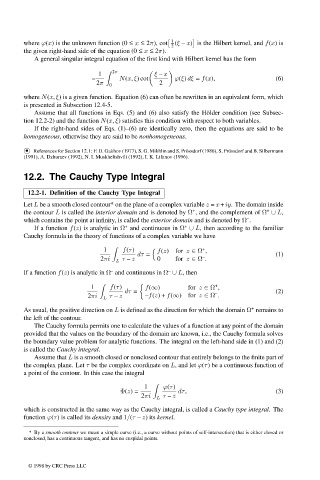Page 615 - Handbook Of Integral Equations
P. 615
1
where ϕ(x) is the unknown function (0 ≤ x ≤ 2π), cot (ξ – x) is the Hilbert kernel, and f(x)is
2
the given right-hand side of the equation (0 ≤ x ≤ 2π).
A general singular integral equation of the first kind with Hilbert kernel has the form
1 2π ξ – x
– N(x, ξ) cot ϕ(ξ) dξ = f(x), (6)
2π 0 2
where N(x, ξ) is a given function. Equation (6) can often be rewritten in an equivalent form, which
is presented in Subsection 12.4-5.
Assume that all functions in Eqs. (5) and (6) also satisfy the H¨ older condition (see Subsec-
tion 12.2-2) and the function N(x, ξ) satisfies this condition with respect to both variables.
If the right-hand sides of Eqs. (1)–(6) are identically zero, then the equations are said to be
homogeneous, otherwise they are said to be nonhomogeneous.
•
References for Section 12.1: F. D. Gakhov (1977), S. G. Mikhlin and S. Pr¨ ossdorf (1986), S. Pr¨ ossdorf and B. Silbermann
(1991), A. Dzhuraev (1992), N. I. Muskhelishvili (1992), I. K. Lifanov (1996).
12.2. The Cauchy Type Integral
12.2-1. Definition of the Cauchy Type Integral
Let L be a smooth closed contour* on the plane of a complex variable z = x+ iy. The domain inside
+
+
the contour L is called the interior domain and is denoted by Ω , and the complement of Ω ∪ L,
–
which contains the point at infinity, is called the exterior domain and is denoted by Ω .
+
+
If a function f(z) is analytic in Ω and continuous in Ω ∪ L, then according to the familiar
Cauchy formula in the theory of functions of a complex variable we have
+
1 f(τ) f(z) for z ∈ Ω ,
dτ = (1)
–
2πi τ – z 0 for z ∈ Ω .
L
–
–
If a function f(z) is analytic in Ω and continuous in Ω ∪ L, then
+
1 f(τ) f(∞) for z ∈ Ω ,
dτ = – (2)
2πi L τ – z –f(z)+ f(∞) for z ∈ Ω .
+
As usual, the positive direction on L is defined as the direction for which the domain Ω remains to
the left of the contour.
The Cauchy formula permits one to calculate the values of a function at any point of the domain
provided that the values on the boundary of the domain are known, i.e., the Cauchy formula solves
the boundary value problem for analytic functions. The integral on the left-hand side in (1) and (2)
is called the Cauchy integral.
Assume that L is a smooth closed or nonclosed contour that entirely belongs to the finite part of
the complex plane. Let τ be the complex coordinate on L, and let ϕ(τ) be a continuous function of
a point of the contour. In this case the integral
1 ϕ(τ)
Φ(z)= dτ, (3)
2πi L τ – z
which is constructed in the same way as the Cauchy integral, is called a Cauchy type integral. The
function ϕ(τ) is called its density and 1/(τ – z) its kernel.
*By a smooth contour we mean a simple curve (i.e., a curve without points of self-intersection) that is either closed or
nonclosed, has a continuous tangent, and has no cuspidal points.
© 1998 by CRC Press LLC
© 1998 by CRC Press LLC
Page 598

